

Good Ideas - Revisited Niklaus Wirth September 2005 Moscow State University Computer Architecture Programming Languages Miscellaneous Techniques Programming Paradigms
Expression stacks (a/b) + ((c+d)*(c-d)) a b / c d + c d - * + a a/b a/b a/b a/b b c c+d c+d d c d a/b a/b (a/b)+((c+d)*(c-d)) c+d (c+d)*(c-d) c-d
Subroutine return addresses before call SP S S S subroutine subroutine subroutine code code code PC BSR S BSR S BSR S return register stack after call SP PC subroutine subroutine subroutine code code code
Virtual addressing PTR + + + data Level 1 Page table Level 2 Page table Page table entry prot bits address
Benefit and cost of virtual addressing Benefits: • Simplifies allocation in multiprocessing • Simplifies reuse of pages • Protects from illegal access Cost: • Multiple memory access via page tables • Additional hardware • Efficiency requires cashes
Simple vs. complex instruction sets Simple instruction set -> simple hardware What led to complex instruction sets? High-level language constructs Wish for code density Microprogramming Descriptor-architectures (B5500) The concept of computer families The return to RISC architectures
Programming Language Features • Notation and syntax • Algol’s FOR statement • Algol’s OWN variables • Algol’s name parameter
Notation and Syntax • Assignment operator x = y x := y z = x ++ y b = x == y x +++++y ++x+++y+1 x+++++y+1==++x+++y x+++y++==x+++++y+1 • APL: x-y-z means x-(y-z), but not (x-y)-z • Confusion between statement and expression • Statements are executed • Expressions are evaluated
Syntax (Algol and Pascal) if b then S0 if b then S0 else S1 if b0 then if b1 then S0 else S1 if b0 then if b1 then S0 else S1 if b0 then if b1 then S0 else S1 if p then for i := 1 step 1 until n do if q then S1 else S2 if p then for i := 1 step 1 until n do if q then S1 else S2 if b then S0 end if b then S0 else S1 end
Algol’s complicated for ststement for i := 1 step 1 until n do a[i] := 0 for i := 2, 3, 5, 7, 11 do a[i] := 0 for i := x, x+1, x*(y+z) do a[i] := 0 for i := i+1 while i < n do a[i] := 0 for i := x-3, x step k until y, y+7, while z < 20 do a[i] := 0 for i := 1 step 1 until i+1 do a[i] := 0 for i := 1 step i until i do i := -i
Algol’s own variables procedure P(x, y); begin integer z; z := x; x := y; y := z end real procedure random; begin own real x; x := (x*a + b) mod c; randon := x end
Algol’s name parameter real procedure square(x); real x; square := x*x square(a) literally means a*a square(sin(a)*cos(a)) stands for sin(a)*cos(a)*sin(a)*cos(a) real procedure square(x); value x; real x; square := x*x stands for begin real x’; x’ := x; square := x’*x’ end
Algol’s Jensen device real procedure sum(k, x, n); begin real s; for k := 1 step 1 until n do s := s+x; sum := x end a 1 + a 2 + … + a 100 sum(i, a[i], 100) a × b sum(i, a[i]*b[i], 100)
Dijkstra’s “display” procedure P; procedure A(proc h); begin integer i; begin integer x; procedure Q; procedure B; begin integer j; begin integer y; procedure R; procedure C; begin integer k; begin integer z; h end ; end ; A(R) C end ; end ; Q B end end
→ P → Q → A → B → C → R display frame pointer R C B A Q P static link dynamic link
Functional programming • What distinguishes a functional language from a procedure language? • FP: exclusively function application • No state, no variables • FPLs have sneaked in state and assignment • No side effects • Eases detection of potential parallelism • Academic exercise ?
Logic programming • Prolog • Implementation is a search engine for solutions satisfying given predicates • Logic inference engine • In practice requires hints in the form of cuts • One must understand the functioning of the hidden engine • An academic exercise ?
Object-oriented programming • Technically based on 2 concepts only: - procedure types of variables - type extension (inheritance) • View of procedures as belonging to objects • Terminology object (record typed) variable class (record) type method (record bound) procedure send msg call procedure
“Good ideas” of today? • Many of the good ideas of their time have become mediocre or even bad ideas – Because of technology changes – Because of shifts of goals and habits – Because of too much emphasis on efficiency • Which are today’s “good ideas”? – Will they also turn mediocre? – Or are they bad already now?
Recommend
More recommend